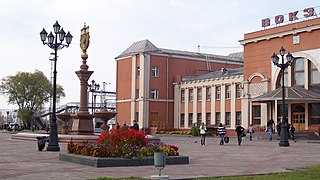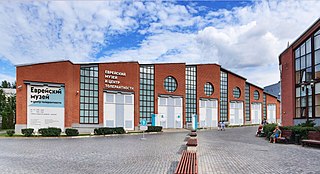
The Jewish Autonomous Oblast is a federal subject of Russia in the far east of the country, bordering Khabarovsk Krai and Amur Oblast in Russia and Heilongjiang province in China. Its administrative center is the town of Birobidzhan.

Birobidzhan, also spelt Birobijan, is a town and the administrative centre of the Jewish Autonomous Oblast, Russia, located on the Trans-Siberian Railway, near the China–Russia border.

The history of the Jews in Russia and areas historically connected with it goes back at least 1,500 years. Jews in Russia have historically constituted a large religious and ethnic diaspora; the Russian Empire at one time hosted the largest population of Jews in the world. Within these territories, the primarily Ashkenazi Jewish communities of many different areas flourished and developed many of modern Judaism's most distinctive theological and cultural traditions, while also facing periods of antisemitic discriminatory policies and persecution, including violent pogroms.
A Yevsektsiya were the Jewish section of the Soviet Communist Party and its main institutions. These sections were established in fall of 1918 with consent of Vladimir Lenin to carry Party ideology and Marxist-Leninist atheism to the Soviet Jewish masses. The Yevsektsiya published a Yiddish periodical, der Emes. According to Walter Kolarz, the Yevsektsiya inside the League of Militant Godless, "had a total of 40,000 Jewish members in 1929, the year when the anti-religious campaign was at its peak. These 'Jewish sections' were much despised by the bulk of Russia's Jewry. Their members were regarded with as much contempt as the Jewish renegades who turned persecutors of the own brethren in the Middle Ages."
NKVD troika or Special troika, in Soviet history, were the People's Commissariat of Internal Affairs made up of three officials who issued sentences to people after simplified, speedy investigations and without a public trial. The three members were judge and jury, though they themselves did not carry out the sentences they dealt. These commissions were employed as instruments of extrajudicial punishment introduced to supplement the Soviet legal system with a means for quick and secret execution or imprisonment. It began as an institution of the Cheka, then later became prominent again in the NKVD, when it was used during the Great Purge to execute many hundreds of thousands of Soviet citizens. Defendants in the Troika's proceeding were typically not entitled to legal aid or the presumption of innocence. Convictions usually did not include information about the actual incriminating evidence and basically contained only information about indictment and sentencing. The outcome of such trials was often determined before it even began due to targeted numbers of citizens to be executed or imprisoned in Gulag prison camps.

Komzet was the Committee for the Settlement of Toiling Jews on the Land in the Soviet Union. The primary goal of the Komzet was to help impoverished and persecuted Jewish population of the former Pale of Settlement to adopt agricultural labor. Other goals were getting financial assistance from the Jewish diaspora and providing the Soviet Jews an alternative to Zionism.

The history of the Jews in Ukraine dates back over a thousand years; Jewish communities have existed in the modern territory of Ukraine from the time of the Kievan Rus'. Important Jewish religious and cultural movements, from Hasidism to Zionism, arose there. According to the World Jewish Congress, the Jewish community in Ukraine constitutes Europe's third-largest and the world's fifth-largest.
Semyon (Shimen) Markovich Dimanshtein was a Soviet state official, publisher, and leading theorist of national issues in the USSR, and one of the founders of the Soviet Oriental studies. He was considered by the Soviet government to be a representative of Soviet Jews.
There were several proposals for a Jewish state in the course of Jewish history between the destruction of ancient Israel and the founding of the modern State of Israel. While some of those have come into existence, others were never implemented. The Jewish national homeland usually refers to the State of Israel or the Land of Israel, depending on political and religious beliefs. Jews and their supporters, as well as their detractors and anti-Semites have put forth plans for Jewish states.

The Jewish Territorial Organisation, known as the ITO, was a Jewish political movement which first arose in 1903 in response to the British Uganda Scheme, but only institutionalized in 1905. Its main goal was to find an alternative territory to that of Palestine, which was preferred by the Zionist movement, for the creation of a Jewish homeland. The organization embraced what became known as Jewish Territorialism also known as Jewish Statism. The ITO was dissolved in 1925.
The accusation that Joseph Stalin was antisemitic is much discussed by historians. Although part of a movement that included Jews and rejected antisemitism, he privately displayed a contemptuous attitude toward Jews on various occasions that were witnessed by his contemporaries, and are documented by historical sources. Stalin argued that the Jews possessed a national character but were not a nation and were thus unassimilable. He argued that Jewish nationalism, particularly Zionism, was hostile to socialism. In 1939, he reversed communist policy and began a cooperation with Nazi Germany that included the removal of high-profile Jews from the Kremlin. As dictator of the Soviet Union, he promoted repressive policies that conspicuously impacted Jews shortly after World War II, especially during the anti-cosmopolitan campaign. At the time of his death, Stalin was planning an even larger campaign against Jews, which included the deportation of all Jews within the Soviet Union to Northern Kazakhstan. According to his successor Nikita Khrushchev, Stalin was fomenting the doctors' plot as a pretext for further anti-Jewish repressions.
The history of the Jews in the Jewish Autonomous Oblast (JAO), Russia, began with the early settlements of 1928.

The Organization for Jewish Colonization in Russia, commonly known by its transliterated acronym of ICOR, was a Communist-sponsored mass organization in North America devoted to supporting the settlement of Jews in new collective settlements, firstly in the newly established Ukrainian Soviet Republic and Southern Russia, and latterly in the Jewish Autonomous Oblast in Siberia. The organization was founded in the United States in 1924 and soon spread to Canada.
![<i>Seekers of Happiness</i> 1936 [[USSR]] film](https://upload.wikimedia.org/wikipedia/en/2/20/Seekers_of_Happiness.jpg)
Seekers of Happiness is a Soviet film from 1936 trying to attract Jews to the Jewish Autonomous Oblast (JAO) in the far east of the USSR. It is also known by its alternative name, A Greater Promise.

The General Jewish Labour Bund in Lithuania, Poland and Russia, generally called The Bund or the Jewish Labour Bund, was a secular Jewish socialist party initially formed in the Russian Empire and active between 1897 and 1920. In 1917, the Bund organizations in Poland seceded from the Russian Bund and created a new Polish General Jewish Labour Bund which continued to operate in Poland in the years between the two world wars. The majority faction of the Russian Bund was dissolved in 1921 and incorporated into the Communist Party. Other remnants of the Bund endured in various countries. A member of the Bund was called a Bundist.

Aron Isaakovich Vainshtein, known by the nom de guerreRakhmiel, was a Jewish socialist activist and politician in Soviet Belorussia.

Jewish autonomy in Crimea was a project in the Soviet Union to create an autonomous region for Jews in the Crimean peninsula carried out during the 1920s and 1930s. Following WWII and the creation of the Jewish Autonomous Oblast in the Far East, the project was abandoned, despite the existence of more than 80 kolkhozes and an attempt to renew the project in 1944 by the Jewish Anti-Fascist Committee.

The Jewish Labour Bund, more commonly known as the Jewish Labour Bund Melbourne, the Australian Bund, or simply the Bund, is the Australian wing of the Bundist movement. It was a member of the historical International Jewish Labor Bund, and is the largest and most active Bundist organisation left in the world. It was founded in 1928 Jewish Polish immigrants, and expanded rapidly after the Second World War with the mass arrival of Holocaust survivors to Australia. The Bund is currently registered only in the state of Victoria, where it is legally known as the Jewish Labour Bund, Inc., and is based primarily in the city of Melbourne.
The Gezerd was a Communist organisation of Australian Jews that promoted the settlement of Jews in Eastern Siberia, along with pro-Soviet positions. It was active in Melbourne and Sydney. The organisation was co-founded by the recent Polish Jewish immigrant & Bundist Sender Burstin. In its early years it cooperated strongly with the Jewish Labour Bund in Australia; including the formation of a Joint Culture Committee, however the two organisations split over the Molotov-Ribbentrop Pact along with the expelling of Sender Burstin as a "Social-Fascist". The organisation supported the activities of the Soviet Komzet in trying to build an alternative Jewish Homeland in Birobidzhan, working as a local wing of the public relations organisation OZET for this purpose. Towards these ends, it raised some £50 (Australian) within its first year to help with the settlement there, along with a microscope and an x-ray in 1934. The group also maintained strong ties with the Communist Party of Australia, although never formally joined or affiliated with the organisation. Beyond its support of Soviet policies, the group also engaged in yiddish culture events; including founding a "Culture House" in Carlton in 1938 and running a Yiddish theatre troupe between 1932 and 1937, efforts to support the integration of migrants, and events around international policy; especially the rise of fascism. It also supported the international boycott of German goods, and organised meetings against the political violence of the Nazi Regime against "Jews, Catholics, workers, and intellectuals". The group put itself at odds with the traditional Anglo-Jewery of Australia, positioning itself against Religious and ideologically Conservative elements of Australian Jewery: being described as an 'undesirable foreign element' by Newman Rosenthal, right-leaning editor of the Australian Jewish Herald newspaper. The organisation continued despite the liquidation of the Soviet OZET in 1938, apparently not aware of this event.
The region of Siberia has been home to Jews since the late 18th century, although Jewish communities did not exist in large part until after 1861, when Tsar Alexander II lifted the restrictions of his father, Tsar Nikolai I regarding Jews in the Pale of Settlement.









![<i>Seekers of Happiness</i> 1936 [[USSR]] film](https://upload.wikimedia.org/wikipedia/en/2/20/Seekers_of_Happiness.jpg)



